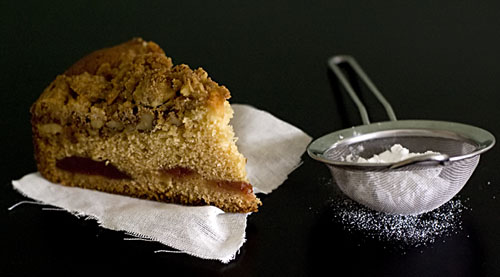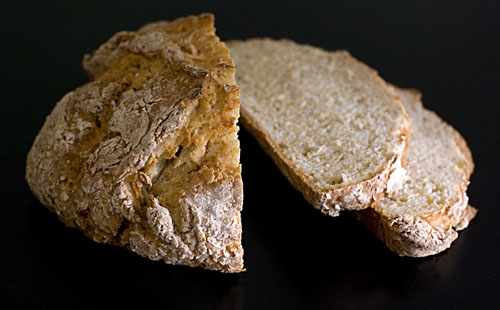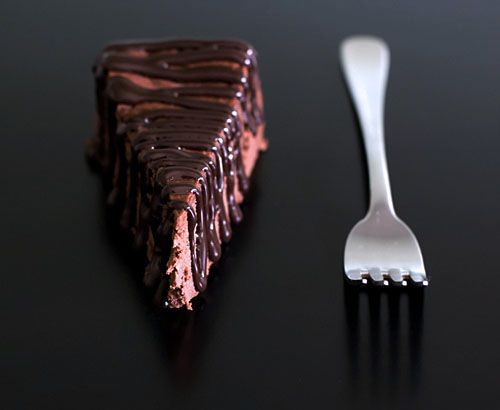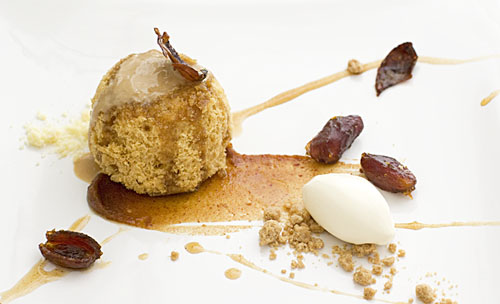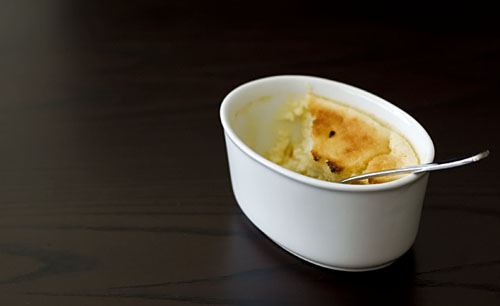When life gives you quinces..
When life gives you quinces, make quince crumble cake.
It is for those days that rush by too fast. When seasons turn from singlet tops and insects thumping angrily at the screen door, to leaves tumbling onto wet pavements, the scent of wool scarves, the whirr of the stand mixer, the hum of the oven, and suddenly.. quince crumble cake.
It is also for one of those days. We’ve all had them. Usually a cup of tea, a heat pack around my neck and a little grumble to B, sets things straight. Failing that, I call upon ‘the army’.
There are millions of recipes out there for all sorts of simple cakes and breads. I guess the ones I use are no different, but they are so reliable and so delicious that I now consider them part of my personal army. My army battles against such days that defeat and exhaust. I’ve been experiencing many such days recently, and have gratefully discovered that it’s quite soothing to be able to make something simple not only for myself, but to share with others as well.
The quince crumble cake is my version of Rose Levy Beranbaum’s “apple-cinnamon crumb coffee cake”. I substituted some ingredients and modified the instructions, to simplify the cobbling together of the cake batter. Using my method, the fruit will sink into the cake but I’m okay with that. The heap of crumble on top is a textural delight.
The soda bread recipe, which has now become my daily bread, is by Fergus Henderson. No changes there; it’s as simple as it gets. The (gluten-free) chocolate chestnut cake is from Nigella Lawson’s How to be a Domestic Goddess.
Below are two of the recipes that I hope will find a home within your own army.
Quince and Walnut Crumble Cake :
For the cinnamon crumble :
100g walnut halves
72g light brown sugar
25g caster sugar
1 1/2 teaspoons cinnamon
65g plain flour
57g unsalted butter, melted
Place all the dry ingredients in a bowl. Add the butter and rub it in or toss through to form a crumbly mixture (use your fingers to break any of the larger pieces of walnut into smaller chunks). Set aside.
For the cake :
6 quinces halves, slow cooked in a 60% sugar syrup solution flavoured with vanilla, lemon zest and cinnamon, drained and sliced or chopped into small chunks (or fresh fruit of choice)
2 large eggs, at room temperature
100g + 60g Greek/European-style yogurt
1 1/2 teaspoons vanilla extract
200g plain flour
170g caster sugar
1/2 teaspoon baking powder
1/2 teaspoon baking soda
1/4 teaspoon salt
170g unsalted butter, softened
Preheat the oven to 175’C.
In a small bowl, combine the eggs, 60g yogurt and vanilla.
In a stand mixer fitted with the flat beater, add the flour, sugar, baking powder, baking soda and salt. Add the butter and 100g yogurt. Mix on low until dry ingredients are moistened, then mix on medium speed for 1 1/2 minutes. Lower the speed and gradually add the egg mixture. Scrape down the sides of the bowl then beat for 30 seconds to fully incorporate all the ingredients.
Spread the batter into a greased and lined 22cm tin. Top with slices of the cooked quince, then the crumble. Bake for about 50 – 60 minutes. A skewer inserted into the cake should come out clean. At about the 30 minute mark, you may want to rotate the cake pan for even browning. At this point if the crumble appears to be browning too quickly, you can also cover the top of the pan with some foil and continue baking.
Soda Bread :
(From Beyond Nose to Tail by Fergus Henderson and Justin Piers Gellatly)
140g wholemeal self-raising flour
140g strong white flour
5g sea salt
10g caster sugar
5g baking powder
125ml water
125ml buttermilk
Mix all the ingredients together by hand in a large mixing bowl (it will be quite wet), then leave the dough to rest in the bowl for 5 minutes.
Shape the dough into a ball and place on a floured baking tray. Sprinkle with flour and cut a cross in the top about 4cm long on each side and 1cm deep. Leave to rest for 10 minutes, then place in an oven preheated to 200’C. Bake for 40 minutes, until golden brown. To test if the loaf is done, turn it over and tap it on the bottom with your finger; if it sounds hollow it is ready. Leave to cool on a wire rack. Serve with plenty of butter.
Tags: bread, buttermilk, cake, chestnut, chocolate, cinnamon, crumble, quince, teacake, walnut, wholemeal

